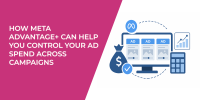Achieving profitable growth on Meta in 2025 will require more than dropping a few creatives into Ads Manager and hoping for the best. Privacy updates, rising CPMs, and relentless competition mean every dollar must pull its weight. The guide below walks you through a complete Facebook ads campaign build from defining objectives to refining bidding.
1. Begin With Outcomes, Not Placements
Starting with crystal-clear outcomes protects you from “random-act-of-marketing” syndrome. Spend ten minutes writing down:
-
A single primary metric. Will you chase a lower average cost per click Facebook or a higher average click through rate on Facebook ads?
-
A time-bound target. For instance, “Hit a 2.0 percent CTR by Q2 2025.”
-
An unambiguous business objective: Awareness, Traffic, Leads, Purchases, or Loyalty.
Documenting these guardrails now gives later decisions on campaign budget optimization and creative direction a solid anchor.
Always define outcomes first: one metric, one deadline, one win.
If you’re still weighing objectives, this breakdown of Meta ad campaign objectives clarifies when to use Awareness, Leads, or Sales.
When you review performance later, ask only one question: “Did today’s spend move us closer to that number?”
2. Research and Re-Segment Your Audience
Audience quality drives everything from ad impressions Facebook to return on ad spend. In 2025, demographic shifts and signal loss make last year’s look-alikes unreliable. Refresh your data workflow in three steps.
-
Collect zero-party and first-party data through surveys, checkout flows, and email.
-
Build micro-segments and interest stacks inside Audience Manager.
-
Check Facebook advertising analytics for spikes or dips in CPM, CTR, and good Facebook ad CTR benchmarks within each segment.
Finish by drafting a short persona narrative — motivations, fears, preferred content format, so creative teams speak to people, not data points.
New to segmentation? Start with Facebook ad targeting basics to see how interests, behaviors, and demographics really work.
3. Nail Your Tracking Stack (Pixel + CAPI)
Ignore tracking and you will live forever in the Meta learning phase. A clean data pipe lets the algorithm optimize quickly and protects you from the dreaded learning limited Facebook ads status.
-
Install both the Facebook Pixel and the Conversion API.
-
Pass four core events: ViewContent, AddToCart, InitiateCheckout, Purchase.
-
Test every signal in Events Manager until diagnostics show green.
Accurate data feeds stronger Facebook ads reporting, sharper attribution windows, and ultimately better Facebook ads metrics.
Clean signals also help you exit the learning phase faster, saving both time and budget.
4. Choose the Right Campaign Architecture
Meta’s Advantage Campaign Budget (ACB), often searched as advantage campaign budget, is the 2025 default. Flip it on and let the system move spend to low-cost results while you focus on strategy.
Before you build, map objectives to optimization events:
Treat this as a starting point. For a low-ticket offer, an Awareness objective optimized for ad impressions Facebook may out-convert a Sales campaign in cold traffic — verify through testing.
These AI text and image tools can crank out hook variations in minutes.
5. Craft Creative That Stops the Scroll
In 2025, attention lasts as long as it takes to swipe. Winning ads combine scroll-stopping visuals with relevance signals the algorithm loves.
-
Vertical video first. Reels placements generate the strongest click rate Facebook ads across multiple industries.
-
Run AI-powered “ads analysis” to generate new hook-variants and CTAs quickly.
-
Layer social proof — UGC clips, review screenshots — to slash CPC by up to 25 percent.
Always label each ad with the hypothesis it tests, so later ads analysis sessions connect spend to learning.
6. Set Smart Budgets and Bids
Overspending too early can trap campaigns in the learning phase. Start with a daily budget about ten times your target CPA and scale logically.
-
Enable rules that hike spend 20 percent after forty-eight hours of cost-efficient results.
-
Use “Cost Per Result Goal” bidding when margins are thin; fall back on “Lowest Cost” when you need volume fast.
-
Track FB pay per click and FB PPC trends weekly to benchmark competitiveness.
Ask yourself after each adjustment: “Will this budget buy statistical significance or just comfort?”
Follow this blueprint on scaling ads safely once your CPA stabilizes.
7. Measure, Analyze, Optimize — Relentlessly
Every forty-eight hours, pull a report and flag each ad as keep, tweak, or kill.
Key panels to monitor:
-
Performance Overview — CTR, CPM, outbound clicks.
-
Engagement Quality — comments, shares, watch-through rate.
-
ROI Hub — cost-per-purchase and blended ROAS.
When metrics plateau, refresh creative or revisit segmentation. Daily, lightweight tweaks prevent big, expensive surprises later.
Red flag? Fix it fast before learning stalls.
If sales stall despite healthy CTRs, walk through this checklist on why Facebook ads don’t convert.
8. Automate the Mundane, Stay Human About Strategy
Automation shines at placement expansion, budget rules, and surfacing “lazy wins.” But decisions on offer, angle, and ethics remain human work.
-
Let automated placements chase cheap retargeting pixels and fresh audiences.
-
Use tracking ads on Facebook alerts to spot anomalies fast.
-
After each quarter, review which automations boosted Facebook ads performance and which needed manual correction.
The highest-performing teams balance machine efficiency with strategic creativity.
Final Thoughts
A breakthrough Facebook ads strategy for 2025 is a living system: clear goals, clean data, disciplined testing, and empathy for your customer. Adopt that mindset and every new Meta campaign update becomes an advantage, not a disruption.
Set your launch date, commit to weekly optimization, and watch the algorithm reward your rigor.
Ready for next-level tweaks? Explore these advanced ROAS tactics to squeeze more profit from every impression.

